Han Wu
A Survey on Generative Recommendation: Data, Model, and Tasks
Oct 31, 2025Abstract:Recommender systems serve as foundational infrastructure in modern information ecosystems, helping users navigate digital content and discover items aligned with their preferences. At their core, recommender systems address a fundamental problem: matching users with items. Over the past decades, the field has experienced successive paradigm shifts, from collaborative filtering and matrix factorization in the machine learning era to neural architectures in the deep learning era. Recently, the emergence of generative models, especially large language models (LLMs) and diffusion models, have sparked a new paradigm: generative recommendation, which reconceptualizes recommendation as a generation task rather than discriminative scoring. This survey provides a comprehensive examination through a unified tripartite framework spanning data, model, and task dimensions. Rather than simply categorizing works, we systematically decompose approaches into operational stages-data augmentation and unification, model alignment and training, task formulation and execution. At the data level, generative models enable knowledge-infused augmentation and agent-based simulation while unifying heterogeneous signals. At the model level, we taxonomize LLM-based methods, large recommendation models, and diffusion approaches, analyzing their alignment mechanisms and innovations. At the task level, we illuminate new capabilities including conversational interaction, explainable reasoning, and personalized content generation. We identify five key advantages: world knowledge integration, natural language understanding, reasoning capabilities, scaling laws, and creative generation. We critically examine challenges in benchmark design, model robustness, and deployment efficiency, while charting a roadmap toward intelligent recommendation assistants that fundamentally reshape human-information interaction.
MoEMeta: Mixture-of-Experts Meta Learning for Few-Shot Relational Learning
Oct 27, 2025Abstract:Few-shot knowledge graph relational learning seeks to perform reasoning over relations given only a limited number of training examples. While existing approaches largely adopt a meta-learning framework for enabling fast adaptation to new relations, they suffer from two key pitfalls. First, they learn relation meta-knowledge in isolation, failing to capture common relational patterns shared across tasks. Second, they struggle to effectively incorporate local, task-specific contexts crucial for rapid adaptation. To address these limitations, we propose MoEMeta, a novel meta-learning framework that disentangles globally shared knowledge from task-specific contexts to enable both effective generalization and rapid adaptation. MoEMeta introduces two key innovations: (i) a mixture-of-experts (MoE) model that learns globally shared relational prototypes to enhance generalization, and (ii) a task-tailored adaptation mechanism that captures local contexts for fast task-specific adaptation. By balancing global generalization with local adaptability, MoEMeta significantly advances few-shot relational learning. Extensive experiments and analyses on three KG benchmarks demonstrate that MoEMeta consistently outperforms existing baselines, achieving state-of-the-art performance.
Beyond Simple Fusion: Adaptive Gated Fusion for Robust Multimodal Sentiment Analysis
Oct 02, 2025



Abstract:Multimodal sentiment analysis (MSA) leverages information fusion from diverse modalities (e.g., text, audio, visual) to enhance sentiment prediction. However, simple fusion techniques often fail to account for variations in modality quality, such as those that are noisy, missing, or semantically conflicting. This oversight leads to suboptimal performance, especially in discerning subtle emotional nuances. To mitigate this limitation, we introduce a simple yet efficient \textbf{A}daptive \textbf{G}ated \textbf{F}usion \textbf{N}etwork that adaptively adjusts feature weights via a dual gate fusion mechanism based on information entropy and modality importance. This mechanism mitigates the influence of noisy modalities and prioritizes informative cues following unimodal encoding and cross-modal interaction. Experiments on CMU-MOSI and CMU-MOSEI show that AGFN significantly outperforms strong baselines in accuracy, effectively discerning subtle emotions with robust performance. Visualization analysis of feature representations demonstrates that AGFN enhances generalization by learning from a broader feature distribution, achieved by reducing the correlation between feature location and prediction error, thereby decreasing reliance on specific locations and creating more robust multimodal feature representations.
Exposing the Cracks: Vulnerabilities of Retrieval-Augmented LLM-based Machine Translation
Oct 01, 2025Abstract:\textbf{RE}trieval-\textbf{A}ugmented \textbf{L}LM-based \textbf{M}achine \textbf{T}ranslation (REAL-MT) shows promise for knowledge-intensive tasks like idiomatic translation, but its reliability under noisy retrieval contexts remains poorly understood despite this being a common challenge in real-world deployment. To address this gap, we propose a noise synthesis framework and new metrics to evaluate the robustness of REAL-MT systematically. Using this framework, we instantiate REAL-MT with Qwen-series models, including standard LLMs and large reasoning models (LRMs) with enhanced reasoning, and evaluate their performance on idiomatic translation across high-, medium-, and low-resource language pairs under synthesized noise. Our results show that low-resource language pairs, which rely more heavily on retrieved context, degrade more severely under noise than high-resource ones and often produce nonsensical translations. Although LRMs possess enhanced reasoning capabilities, they show no improvement in error correction and are even more susceptible to noise, tending to rationalize incorrect contexts. We find that this stems from an attention shift away from the source idiom to noisy content, while confidence increases despite declining accuracy, indicating poor calibration. To mitigate these issues, we investigate training-free and fine-tuning strategies, which improve robustness at the cost of performance in clean contexts, revealing a fundamental trade-off. Our findings highlight the limitations of current approaches, underscoring the need for self-verifying integration mechanisms.
Unbiased Online Curvature Approximation for Regularized Graph Continual Learning
Sep 16, 2025Abstract:Graph continual learning (GCL) aims to learn from a continuous sequence of graph-based tasks. Regularization methods are vital for preventing catastrophic forgetting in GCL, particularly in the challenging replay-free, class-incremental setting, where each task consists of a set of unique classes. In this work, we first establish a general regularization framework for GCL based on the curved parameter space induced by the Fisher information matrix (FIM). We show that the dominant Elastic Weight Consolidation (EWC) and its variants are a special case within this framework, using a diagonal approximation of the empirical FIM based on parameters from previous tasks. To overcome their limitations, we propose a new unbiased online curvature approximation of the full FIM based on the model's current learning state. Our method directly estimates the regularization term in an online manner without explicitly evaluating and storing the FIM itself. This enables the model to better capture the loss landscape during learning new tasks while retaining the knowledge learned from previous tasks. Extensive experiments on three graph datasets demonstrate that our method significantly outperforms existing regularization-based methods, achieving a superior trade-off between stability (retaining old knowledge) and plasticity (acquiring new knowledge).
Adapting Foundation Model for Dental Caries Detection with Dual-View Co-Training
Aug 28, 2025Abstract:Accurate dental caries detection from panoramic X-rays plays a pivotal role in preventing lesion progression. However, current detection methods often yield suboptimal accuracy due to subtle contrast variations and diverse lesion morphology of dental caries. In this work, inspired by the clinical workflow where dentists systematically combine whole-image screening with detailed tooth-level inspection, we present DVCTNet, a novel Dual-View Co-Training network for accurate dental caries detection. Our DVCTNet starts with employing automated tooth detection to establish two complementary views: a global view from panoramic X-ray images and a local view from cropped tooth images. We then pretrain two vision foundation models separately on the two views. The global-view foundation model serves as the detection backbone, generating region proposals and global features, while the local-view model extracts detailed features from corresponding cropped tooth patches matched by the region proposals. To effectively integrate information from both views, we introduce a Gated Cross-View Attention (GCV-Atten) module that dynamically fuses dual-view features, enhancing the detection pipeline by integrating the fused features back into the detection model for final caries detection. To rigorously evaluate our DVCTNet, we test it on a public dataset and further validate its performance on a newly curated, high-precision dental caries detection dataset, annotated using both intra-oral images and panoramic X-rays for double verification. Experimental results demonstrate DVCTNet's superior performance against existing state-of-the-art (SOTA) methods on both datasets, indicating the clinical applicability of our method. Our code and labeled dataset are available at https://github.com/ShanghaiTech-IMPACT/DVCTNet.
AFABench: A Generic Framework for Benchmarking Active Feature Acquisition
Aug 20, 2025Abstract:In many real-world scenarios, acquiring all features of a data instance can be expensive or impractical due to monetary cost, latency, or privacy concerns. Active Feature Acquisition (AFA) addresses this challenge by dynamically selecting a subset of informative features for each data instance, trading predictive performance against acquisition cost. While numerous methods have been proposed for AFA, ranging from greedy information-theoretic strategies to non-myopic reinforcement learning approaches, fair and systematic evaluation of these methods has been hindered by the lack of standardized benchmarks. In this paper, we introduce AFABench, the first benchmark framework for AFA. Our benchmark includes a diverse set of synthetic and real-world datasets, supports a wide range of acquisition policies, and provides a modular design that enables easy integration of new methods and tasks. We implement and evaluate representative algorithms from all major categories, including static, greedy, and reinforcement learning-based approaches. To test the lookahead capabilities of AFA policies, we introduce a novel synthetic dataset, AFAContext, designed to expose the limitations of greedy selection. Our results highlight key trade-offs between different AFA strategies and provide actionable insights for future research. The benchmark code is available at: https://github.com/Linusaronsson/AFA-Benchmark.
LoViC: Efficient Long Video Generation with Context Compression
Jul 17, 2025



Abstract:Despite recent advances in diffusion transformers (DiTs) for text-to-video generation, scaling to long-duration content remains challenging due to the quadratic complexity of self-attention. While prior efforts -- such as sparse attention and temporally autoregressive models -- offer partial relief, they often compromise temporal coherence or scalability. We introduce LoViC, a DiT-based framework trained on million-scale open-domain videos, designed to produce long, coherent videos through a segment-wise generation process. At the core of our approach is FlexFormer, an expressive autoencoder that jointly compresses video and text into unified latent representations. It supports variable-length inputs with linearly adjustable compression rates, enabled by a single query token design based on the Q-Former architecture. Additionally, by encoding temporal context through position-aware mechanisms, our model seamlessly supports prediction, retradiction, interpolation, and multi-shot generation within a unified paradigm. Extensive experiments across diverse tasks validate the effectiveness and versatility of our approach.
One-shot Face Sketch Synthesis in the Wild via Generative Diffusion Prior and Instruction Tuning
Jun 18, 2025
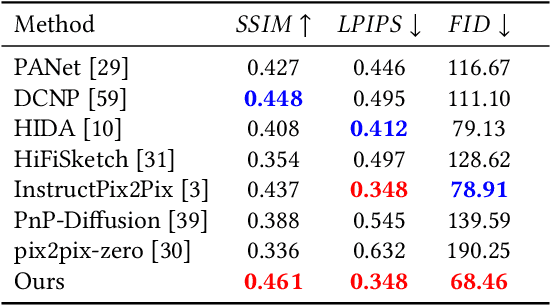
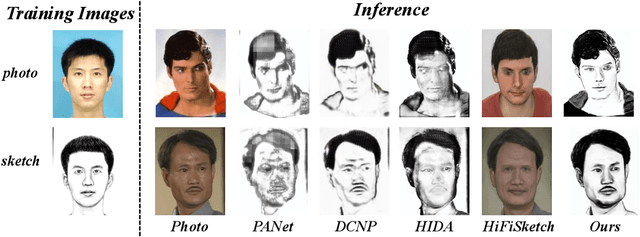

Abstract:Face sketch synthesis is a technique aimed at converting face photos into sketches. Existing face sketch synthesis research mainly relies on training with numerous photo-sketch sample pairs from existing datasets. However, these large-scale discriminative learning methods will have to face problems such as data scarcity and high human labor costs. Once the training data becomes scarce, their generative performance significantly degrades. In this paper, we propose a one-shot face sketch synthesis method based on diffusion models. We optimize text instructions on a diffusion model using face photo-sketch image pairs. Then, the instructions derived through gradient-based optimization are used for inference. To simulate real-world scenarios more accurately and evaluate method effectiveness more comprehensively, we introduce a new benchmark named One-shot Face Sketch Dataset (OS-Sketch). The benchmark consists of 400 pairs of face photo-sketch images, including sketches with different styles and photos with different backgrounds, ages, sexes, expressions, illumination, etc. For a solid out-of-distribution evaluation, we select only one pair of images for training at each time, with the rest used for inference. Extensive experiments demonstrate that the proposed method can convert various photos into realistic and highly consistent sketches in a one-shot context. Compared to other methods, our approach offers greater convenience and broader applicability. The dataset will be available at: https://github.com/HanWu3125/OS-Sketch
Application-Driven Value Alignment in Agentic AI Systems: Survey and Perspectives
Jun 11, 2025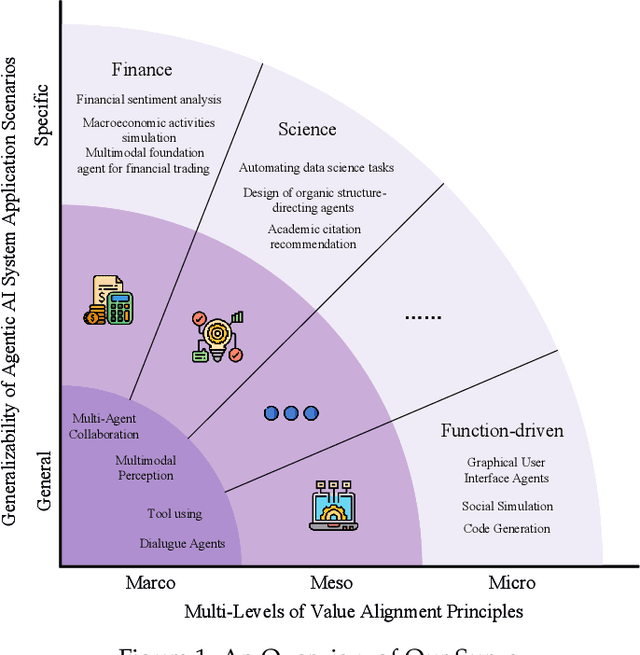
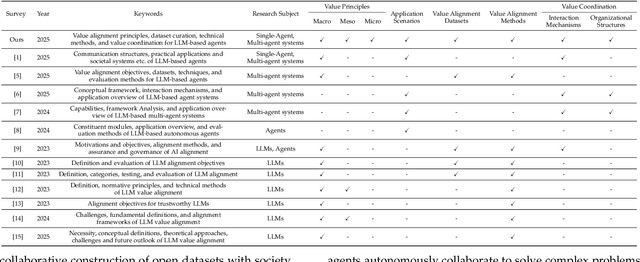
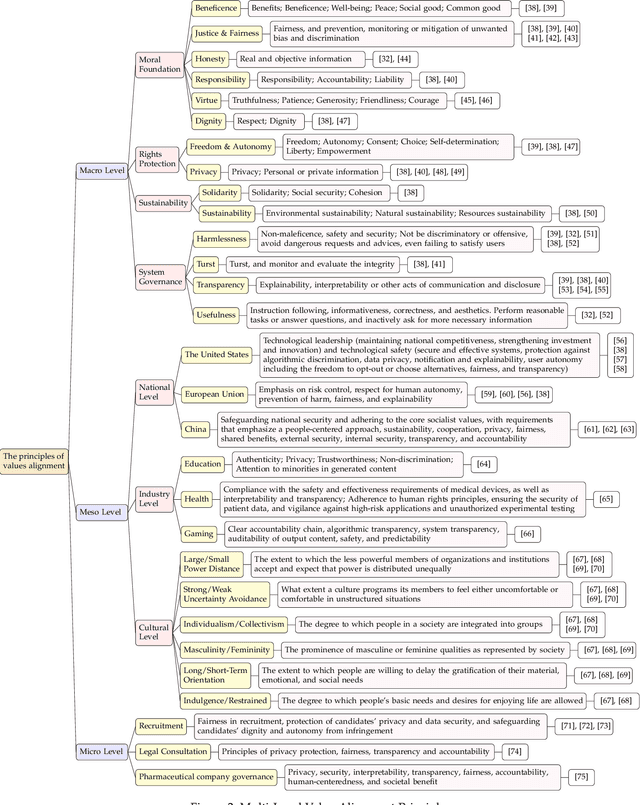
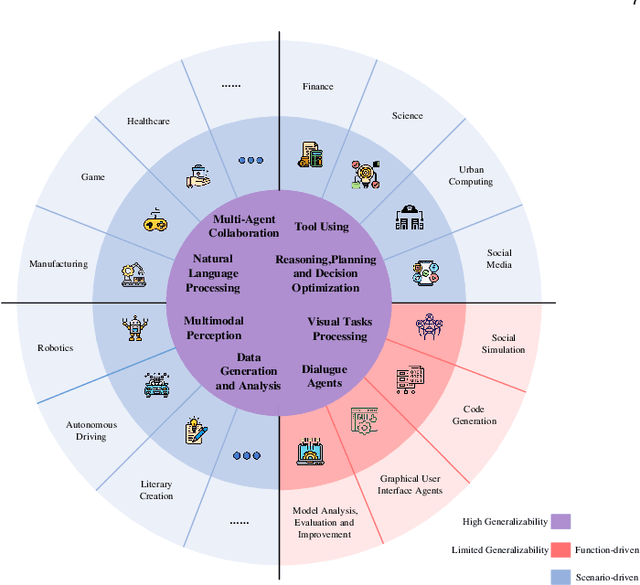
Abstract:The ongoing evolution of AI paradigms has propelled AI research into the Agentic AI stage. Consequently, the focus of research has shifted from single agents and simple applications towards multi-agent autonomous decision-making and task collaboration in complex environments. As Large Language Models (LLMs) advance, their applications become more diverse and complex, leading to increasingly situational and systemic risks. This has brought significant attention to value alignment for AI agents, which aims to ensure that an agent's goals, preferences, and behaviors align with human values and societal norms. This paper reviews value alignment in agent systems within specific application scenarios. It integrates the advancements in AI driven by large models with the demands of social governance. Our review covers value principles, agent system application scenarios, and agent value alignment evaluation. Specifically, value principles are organized hierarchically from a top-down perspective, encompassing macro, meso, and micro levels. Agent system application scenarios are categorized and reviewed from a general-to-specific viewpoint. Agent value alignment evaluation systematically examines datasets for value alignment assessment and relevant value alignment methods. Additionally, we delve into value coordination among multiple agents within agent systems. Finally, we propose several potential research directions in this field.
 Add to Chrome
Add to Chrome Add to Firefox
Add to Firefox Add to Edge
Add to Edge